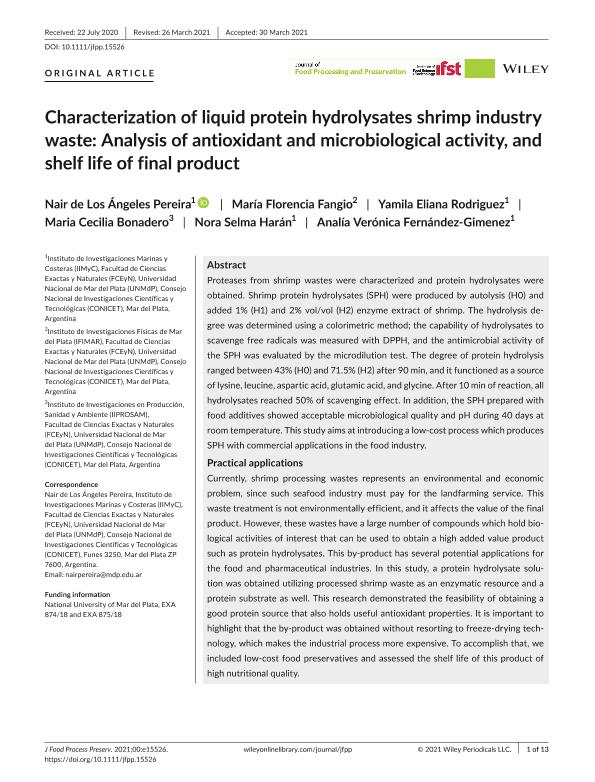Artículo
Characterization of liquid protein hydrolysates shrimp industry waste: Analysis of antioxidant and microbiological activity, and shelf life of final product
Pereira, Nair de Los Angeles ; Fangio, Maria Florencia
; Fangio, Maria Florencia ; Rodriguez, Yamila Eliana
; Rodriguez, Yamila Eliana ; Bonadero, María Cecilia
; Bonadero, María Cecilia ; Haran, Nora Selma; Fernandez Gimenez, Analia Veronica
; Haran, Nora Selma; Fernandez Gimenez, Analia Veronica
 ; Fangio, Maria Florencia
; Fangio, Maria Florencia ; Rodriguez, Yamila Eliana
; Rodriguez, Yamila Eliana ; Bonadero, María Cecilia
; Bonadero, María Cecilia ; Haran, Nora Selma; Fernandez Gimenez, Analia Veronica
; Haran, Nora Selma; Fernandez Gimenez, Analia Veronica
Fecha de publicación:
08/2022
Editorial:
Wiley Blackwell Publishing, Inc
Revista:
Journal of Food Processing and Preservation
ISSN:
0145-8892
Idioma:
Inglés
Tipo de recurso:
Artículo publicado
Clasificación temática:
Resumen
Proteases from shrimp wastes were characterized and protein hydrolysates were obtained. Shrimp protein hydrolysates (SPH) were produced by autolysis (H0) and added 1% (H1) and 2% vol/vol (H2) enzyme extract of shrimp. The hydrolysis degree was determined using a colorimetric method; the capability of hydrolysates to scavenge free radicals was measured with DPPH, and the antimicrobial activity of the SPH was evaluated by the microdilution test. The degree of protein hydrolysis ranged between 43% (H0) and 71.5% (H2) after 90 min, and it functioned as a source of lysine, leucine, aspartic acid, glutamic acid, and glycine. After 10 min of reaction, all hydrolysates reached 50% of scavenging effect. In addition, the SPH prepared with food additives showed acceptable microbiological quality and pH during 40 days at room temperature. This study aims at introducing a low-cost process which produces SPH with commercial applications in the food industry. Practical applications: Currently, shrimp processing wastes represents an environmental and economic problem, since such seafood industry must pay for the landfarming service. This waste treatment is not environmentally efficient, and it affects the value of the final product. However, these wastes have a large number of compounds which hold biological activities of interest that can be used to obtain a high added value product such as protein hydrolysates. This by-product has several potential applications for the food and pharmaceutical industries. In this study, a protein hydrolysate solution was obtained utilizing processed shrimp waste as an enzymatic resource and a protein substrate as well. This research demonstrated the feasibility of obtaining a good protein source that also holds useful antioxidant properties. It is important to highlight that the by-product was obtained without resorting to freeze-drying technology, which makes the industrial process more expensive. To accomplish that, we included low-cost food preservatives and assessed the shelf life of this product of high nutritional quality.
Archivos asociados
Licencia
Identificadores
Colecciones
Articulos (IIPROSAM)
Articulos de INSTITUTO DE INVESTIGACIONES EN PRODUCCION, SANIDAD Y AMBIENTE
Articulos de INSTITUTO DE INVESTIGACIONES EN PRODUCCION, SANIDAD Y AMBIENTE
Articulos(IFIMAR)
Articulos de INST.DE INVESTIGACIONES FISICAS DE MAR DEL PLATA
Articulos de INST.DE INVESTIGACIONES FISICAS DE MAR DEL PLATA
Articulos(IIMYC)
Articulos de INSTITUTO DE INVESTIGACIONES MARINAS Y COSTERAS
Articulos de INSTITUTO DE INVESTIGACIONES MARINAS Y COSTERAS
Citación
Pereira, Nair de Los Angeles; Fangio, Maria Florencia; Rodriguez, Yamila Eliana; Bonadero, María Cecilia; Haran, Nora Selma; et al.; Characterization of liquid protein hydrolysates shrimp industry waste: Analysis of antioxidant and microbiological activity, and shelf life of final product; Wiley Blackwell Publishing, Inc; Journal of Food Processing and Preservation; 46; 8; 8-2022; 1-13
Compartir
Altmétricas



